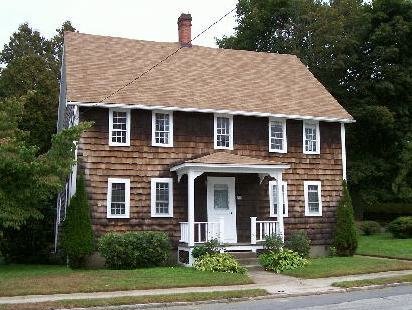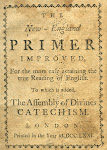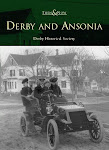Every window in my home is a vintage window. None is original, as the true originals are all long gone. But nonetheless, my windows are all still very old. My sashes consist of pegged mortise and tenon joinery, with thick muntins arranged in 9/6, 12/8, or 6/6 patterns of lights. Not a single one of my window frames is completely square, nor does any sash tightly fit its frame.
Every one of my twenty-three windows leaks air like a sieve, and is in need of much general repair, including repair of nearly all the sills and exterior casings, complete re-painting (including the safe and legal removal of deteriorating layers of lead paint), and re-glazing of all the panes. Perhaps now, you can fully understand exactly why I love this old home so much!
 One of the oldest windows in the house is the small 6/6 in the second floor spinning room.
One of the oldest windows in the house is the small 6/6 in the second floor spinning room.Of course, not a single window is to be replaced. My preservation ethic requires me to ensure these windows will last another 200+ years. But I am also determined to resolve their various functional and performance deficiencies, as well. There's just no way around that -- I need to have a comfortable, livable, and energy-efficient home. And yet, this must be done in a manner that minimizes impact on historically-significant structures and materials, even if it means more work or greater cost in the end.
Naturally, air leakage, and a general lack of insulating properties, are two significant challenges offered by my old windows. Another is UV protection for the interior of the home. There are several areas of the house -- the south side on the second floor, in particular -- where the solar assault on the interior is pretty intense. A partial solution might be to replace existing panes with new ones of treated glass. That would be fine for broken or cracked panes, but I am unwilling to systematically replace all the ancient bubble-glass. And furthermore, that strategy wouldn't address the insulation issue.
 Installation of the left-hand side bracket of an insulating roller shade.
Installation of the left-hand side bracket of an insulating roller shade.Of course, the simplest and most obvious form of sun/UV protection is a shade or blind. However, I already have primitive window treatments (including things like
fish tail swags and
tobacco cloth panels) that suit the house, but generally don't mesh well with shades or blinds, and certainly provide no protection. (In the winter time, I tend to replace some of these with heavy,
single-draw linen swags, which do a good job insulating, but really aren't pleasing for summer use). So what to do?
Well, I finally concluded that an insulating roller shade -- yes, a roller shade, something I've never been a big fan of -- could actually provide a serviceable solution to the thermal and UV problems, while not detracting too much from the historical window treatments. This could be accomplished as long as the roller shades are mounted high and sufficiently recessed, so as to be obscured by the existing window treatments, while also providing as small a gap as possible between shade and window. Recessing the shade requires an inside mount, if possible, or cutting small mortises into the upper rail casings in situations where an outside mount is a better choice.
So, the particular type of roller shade I selected is comprised of
insulated weaver's cloth and is available from
Country Curtains in Stockbridge, Massachusetts. Insulation is provided by a thin, white foam backing on the side of the fabric facing the window that is claimed to protect against both heat and cold. They're a bit on the pricey side, but I found them to be very well made. I initially sized and ordered just a few shades to start with.
 Using a combination square to align the depth of both ends of the roller.
Using a combination square to align the depth of both ends of the roller.The first window to attempt this history-respecting renovation on was the small 6/6 window of the second floor spinning room, which tends to get a lot of sunlight until about mid-day when the sun is finally over the house. This window is illustrated in the first photo above. The closest fitting roller shade is the smallest one made, and is 22" wide -- too wide to actually fit between the jambs with the mounting hardware installed as intended. But a wider shade mounted on the outside would've interfered with the existing swag and iron curtain rod. So this would take a little creativity to get it to work.
I found I could get the shade to fit inside if I reversed the left-hand bracket before fastening it to the window jamb. The other end of the shade then fit snug against the jamb without a bracket. Once the shade was more-or-less positioned in place, I used a combination square to get the shade parallel to the upper rail, and both ends at the same depth (yes, I am
that fussy about this stuff). This is illustrated by the second and third photos, directly above.
The pulley housing on the right-hand side of the shade has a slight taper and lip toward the bottom on each side, so I figured two pan-head screws over each lip, and one at the top of the housing, would adequately support this end of the shade. I used a punch to mark three screw locations around the perimeter of the pulley housing, as shown below:
 Marking pilot holes.
Marking pilot holes.Next, I temporarily removed the shade, and used a hand driver to drill three pilot holes. I almost invariably use a driver to manually drill small pilots, rather than an electric drill, which in this case wouldn't have fit here, anyway:
 Drilling pilot holes.
Drilling pilot holes.Finally, I replaced the shade and drove the three screws supporting the pulley housing, and the shade was secured:
 The right-hand side of the roller shade mounted, sans supplied mounting bracket.
The right-hand side of the roller shade mounted, sans supplied mounting bracket.The photo below shows the installed shade in its lowered position. A nearly perfect fit:

Well, not exactly a perfect fit. If you look at it straight-on, you can see that the lower, left-hand side of the shade is skewed away from the window jamb, while there likewise is a gap between the jamb and the upper, right-hand side of the shade. This is because of the shape of the window frame itself...it simply isn't square and there's not much to be done about that (it is, after all, what it is). Fortunately, the roller tube of the shade can easily be shifted left or right, so at least I was able to get the best possible coverage of the window:

The photo below shows the lowered shade with the fish tail swag back in place. Also, I put the artwork back after installing the shade. It does not, in my opinion, look half bad:

In the next photo below, the shade has been raised, and as you can see, it is nearly completely hidden by the swag:

From the other side, only a bit of the roller shade is visible. I think I could easily hide it if I were to fold the swag a little better. The draw string is unavoidably visible, but so be it:

So I've declared this particular experiment a success, and will continue outfitting the remaining upstairs windows with these roller shades. Not only will they protect against UV and keep the upstairs rooms cooler in the summer, but they should also provide a degree of thermal insulation in the winter. They certainly won't prevent air infiltration, but once that gets resolved, lowering the shades at night will at least help isolate the cold surface of the window from the warm air moving through the room. Note that the more problematic challenges I'm facing, such as repairing the windows and frames, and getting them relatively air tight, will be reported in many more blog posts to come.
Resources and Further ReadingYagid, Robert, "Should Your Old Wood Windows Be Saved?",
Fine Homebuilding Magazine (No. 210), May, 2010,
Taunton Press, Newtown, CT.
Poole, John, "
Tobacco Cloth Curtains and Other Developments," September, 2009.
Poole, John, "
Wintertime Window Treatments," January, 2009.
Window Covering Safety CouncilPostscript: Edge Seal On Insulating ShadesThere was a good Q&A submission in the December 2010 edition of
The Journal of Light Construction regarding the effectiveness of insulating shades and curtains. In response, contributing Editor Paul Fisette emphasized the need to ensure that edges of such shades are sealed when drawn. This prevents warm air from leaking past the shade and hitting the cold glass surface, diminishing the effective R-value of the insulator while also causing condensation on the glass. Such condensation could eventually cause damage, especially for wooden windows, like mine.
The roller shades I'm using don't operate with tracks on the side edges (few do), but I think I could still achieve a good edge seal if I built out stops for the lower sashes that were in continuous contact with the shade when drawn. Doing so might require the stop to gradually taper from bottom to top. Providing a thin film of felt or foam on the stop where it comes in contact with the back of the shade might also help, as well as weighting the bottoms of the shades slightly. Most of my windows don't have stops in the first place, believe or not, and constructing them is part of my plan for general window repair, anyway.
I'm also going to investigate some tracked solutions as well, however, including window quilts, since the roller shade solution mentioned above won't work where my walls lean inward (yes, very old homes sometimes have a few walls like that!). Did I mention there might be some thermography testing involved in this effort, too?
Postscript: Miscellaneous Views of the Spinning RoomWhile writing this post, I thought I'd share a few pictures of the 2nd floor spinning room. In the distant past, this room was most likely used as a utility room for general indoor tasks, including the spinning of flax into thread (hence, the name). When I first purchased the house, I decided I'd make this room into a quiet refuge for reading and relaxing. The adjoining southeast bed chamber, on the other hand, became my main office, and included all my computers, networking gear, several small book cases, and my favorite large
trestle table.
However, I've now reached a point where my ongoing inspection and mapping of the house frame, as well as other restoration tasks, require me to evacuate the southeast chamber. So I recently moved everything into the spinning room. It's a cozy fit, to say the least, but it's only temporary. And it's not quite that bad.
Here's a view from one of the front bedrooms. The trestle table is my main working desk and computer table, with my Linux workstation caddy-cornered between the trestle and small side tables. I actually enjoy the eclecticism of mixing old with some new (is this
colonialpunk futurism, perhaps?):

A view from the other direction. The traditional-looking writing table against the opposite wall is actually a traditional-looking piece of modern furniture:

I keep one of my favorite books on my desk, supported by a forged iron book holder. It's a reprint of Joseph Moxon's classic
The Art of Joinery, annotated by Christopher Schwarz of
Lost Art Press. This book was first published in 1678, just a few years after my house was built:

Various objects on my writing table include an ink well and pounce pot, candle holder and snuffer, @CaffeinatedLiby's hand made compass book mark, my Rubini gold sweep oar paper weight which I picked up at a Head of the Charles Regatta, and a copy of the
Hawkins Mechanical Dictionary, published by Nehemiah Hawkins, ca. 1909:

Also, my signed copy of Chris Schwarz's annotated
The Joiner and Cabinet Maker, and an antique-looking clock:

One of the samplers hanging on the wall. This one is entitled "Mary Follet, Her Work, Aged 12, 1802." I particularly like this one because the characters and scene look almost like something by William Blake:

Another sampler: "On Virtue." This is a nice piece that looks similar to a primitive home blessing:

Finally, I have a large map chest that I use as a credenza to store papers and working documents. My funky primitive iron lamp with the punched willow tree shade sits on top:

~~FIN~~
 A full lunar eclipse on a winter's night. From the Bilder-Atlas der Sternenwelt, ca. 1888 [Image source: Wikipedia Commons]
A full lunar eclipse on a winter's night. From the Bilder-Atlas der Sternenwelt, ca. 1888 [Image source: Wikipedia Commons]



























































